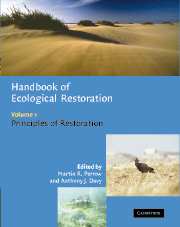Book contents
- Frontmatter
- Contents
- List of contributors
- Foreword
- Preface
- Part 1 The background
- Part 2 Manipulation of the physical environment
- Part 3 Manipulation of the chemical environment
- Part 4 Manipulation of the biota
- 12 Establishment and manipulation of plant populations and communities in terrestrial systems
- 13 Ecology and management of plants in aquatic ecosystems
- 14 Micro-organisms
- 15 Terrestrial invertebrates
- 16 Aquatic invertebrates
- 17 Fish
- 18 Reptiles and amphibians
- 19 Birds
- 20 Mammals
- Part 5 Monitoring and appraisal
- Index
- References
18 - Reptiles and amphibians
Published online by Cambridge University Press: 29 December 2009
- Frontmatter
- Contents
- List of contributors
- Foreword
- Preface
- Part 1 The background
- Part 2 Manipulation of the physical environment
- Part 3 Manipulation of the chemical environment
- Part 4 Manipulation of the biota
- 12 Establishment and manipulation of plant populations and communities in terrestrial systems
- 13 Ecology and management of plants in aquatic ecosystems
- 14 Micro-organisms
- 15 Terrestrial invertebrates
- 16 Aquatic invertebrates
- 17 Fish
- 18 Reptiles and amphibians
- 19 Birds
- 20 Mammals
- Part 5 Monitoring and appraisal
- Index
- References
Summary
INTRODUCTION
Amphibians and reptiles are important components of many ecosystems and reach high levels of biodiversity and biomass in many tropical areas, where most species are to be found. They occur at several trophic levels and have important interactions with other species. Besides the more obvious ones of being predators and prey, some lizards are important plant pollinators and tortoises may disperse seeds and maintain grazing climax communities.
World-wide there are about 12000 species of reptiles and amphibians, about a quarter of known vertebrate species. Currently only 5.5% of amphibian and reptilian species are considered threatened or endangered, but this is probably an underestimate. Many populations have been disrupted by habitat change, destruction and fragmentation and by the impacts of exotic species and disease. Efforts to conserve them have mostly been passive by passing legislation and habitat protection, but there are increasing efforts to restore populations through habitat restoration, and by the intensive management of the threatened species. In many cases there have been efforts to replace extirpated populations with animals translocated from healthy wild populations or captivity.
The restoration of depleted or extirpated reptile and amphibian populations is a realistic goal even though there are, considering the number of species, relatively few successful cases. Nevertheless, even though our efforts may seem crude we have to pursue the goal of restoring populations and communities for the techniques being developed have wide currency for the conservation of reptiles and amphibians globally.
- Type
- Chapter
- Information
- Handbook of Ecological Restoration , pp. 355 - 375Publisher: Cambridge University PressPrint publication year: 2002
References
- 10
- Cited by



